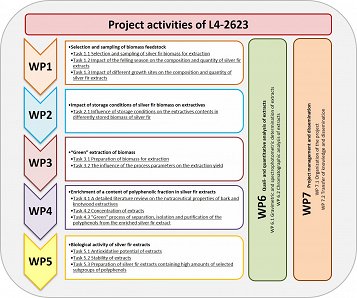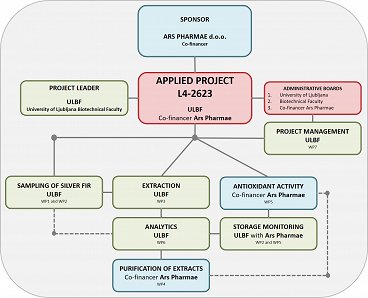Contract number
L4-2623
Department:
Department of wood science and technology
Type of project
ARIS projects
Type of project
Aplikativni
Role
Lead
Financing
Ars Pharmae d.o.o
Duration
01.09.2020 - 31.08.2023
Total
1.26 FTE
Project manager at BF
Vek ViljemAbstract
In the kingdom of plants, conifer trees have one of the highest concentrations of polyphenols in those parts of the tree that represent the residue or waste in the forest wood chain. Bark and knots of conifers contain large quantities of flavonoids, lignans, stilbenes and tannins, which exhibit biological, pharmacological and clinical effects, such as cardiovascular disease prevention, cancer prevention, and anti-inflammatory, antidiabetic and antimicrobial activity. The content of polyphenolic extracts in a tree depends on all factors that influence the growth of a tree, as well as on the manner of handling, storage and extraction of biomass and on the storage of the extracts. The production of well-defined polyphenolic extracts requires understanding the role of all influencing factors, which requires in-depth research. Based on this knowledge, protocols can be developed for all stages in the extraction process. The aim of the project proposal is the production of two polyphenolic extracts from the tissues of silver fir with a well-defined polyphenolic composition and optimization of the entire production process. This includes technological and methodological research of the effective separation of bark and knots from logs of silver firs, the impact of the season and different growth sites on the content and composition of the polyphenolic fraction in biomass, the study of the impact of biomass handling and storage on the quality and quantity of extracts, and the determination of the green extraction process, which will provide optimum yields and constant composition of the target polyphenols. We will study the antioxidant properties and the stability of the extracts obtained. Based on the findings, protocols will be developed for the whole chain of silver fir polyphenolic extracts production, which will foster co-financer of the project to produce sufficient quantities and permanent quality of polyphenolic extracts to develop new nutritional supplements and provide a basis for the transition to a higher technological level. Cascading use of biomass demonstrated in this proposal will be applicable in other parts of the forest-wood value chain.
The phases of the project and their realization
| The project group consists of two project teams, first as ULBF (University of Ljubljana, Department of wood science and technology) and the second as co-financing company Ars Pharmae d.o.o. (Figure 2). The implementation of activities and timing of the project are designed to achieve the objectives of the proposal and are directed toward predicted project deliverables and essential milestones (Figure 1 and Table 1). The presentation of activities and organization of work packages (WP1-WP7) for the realization of project goals by phases is shown in Figure 1, and Table 1 presents the most important milestones (MS1-MS11). |
The sampling of trees and collecting the bark and knotwood samples (WP 1 and WP 2) will be done by ULBF. Co-financer Ars Pharmae will help to organize and manage the activities within the WPs. The implementation of WP 1 and WP 2 in state forests will be managed by the Kočevski les d.o.o. University of Ljubljana (ULBF) and Kočevski les d.o.o. are tightly cooperating in the Strategic Innovation Development Partnership (SRIP) of the Network for the Transition to the Circular Economy, within the focus area Biomass and Alternative Raw Materials (Head, prof. dr. Primož Oven). Logs will be delivered by Kočevski les d.o.o. to their partner company, where the sampling and storage of both bark and knotwood will be studied in the real technological process (WP 2). This and the company's willingness to support emerging forestry wood value chains ensure the implementation of the sustainable selection of trees, harvesting and dissection of the material (WP 1). Eventual anatomical reasons for the poor separation of the bark and knotwood from tree stem will be studied by ULBF. Discs will be dissected and samples of bark and knotwood prepared in the carpentry workshop of ULBF. Antioxidant potential of bark and knotwood extractives will be examined within in WP 5 with cofinancer Ars Pharmae as leader. ULBF will be involved in WP 5 by testing antioxidant potential by means of spectrophotometric methods. Study of stability of extracts at ULBF will be performed in laboratory condition and by using an artificial accelerated weathering device. The oxygen radical absorbance capacity assay and the cellular antioxidative assay is going to be organized and done by the co-financer Ars Pharmae with external partners. Extractions (WP 3), spectrophotometric and chromatographic studies (WP 6) of extracts as well research activities on purification/isolation (WP 4) will be done in laboratories of ULBF.
Figure 1 schematic presentation on the organisation of work packages (WP 1 to WP 7)
Figure 2 An organizational structure of applied project L4-2623
Table 1 List of milestones (MS)
| Milestones | Description |
| MS 1 | All experimental trees cut down in Kočevska forest |
| MS 9 | First year report |
| MS 2 | Trees cut down in all experimental growth sites (Notranjska, Gorenjska, Pohorje) |
| MS 3 | First quantities of extractives delivered to WP4 for testing antioxidant properties |
| MS 4 | Optimized batch process of extraction |
| MS 6 | Variability in the composition and content of extractives in silver fir trees with respect the season of felling, growth site and storage conditions |
| MS 10 | Second year report |
| MS 5 | Optimized polyphenol fraction separation |
| MS 7 | Defined and optimized the entire process of production of extracts from bark and knotwood of silver fir |
| MS 8 | Two bark and knotwood extracts of silver fir with high concentration of polyphenols |
| MS 11 | Final report |
External link to link to SICRIS Open in new window


